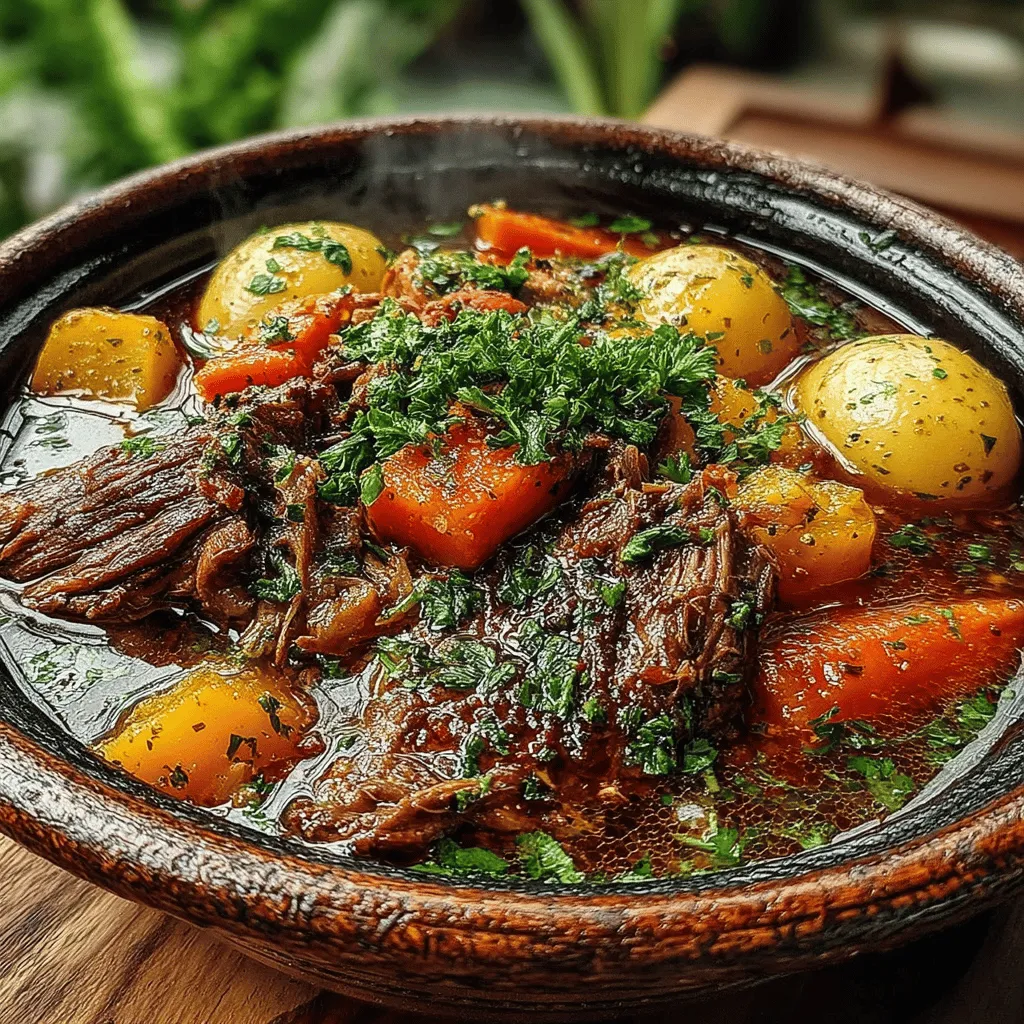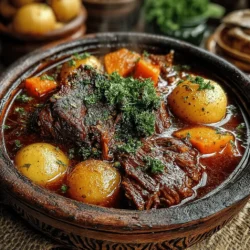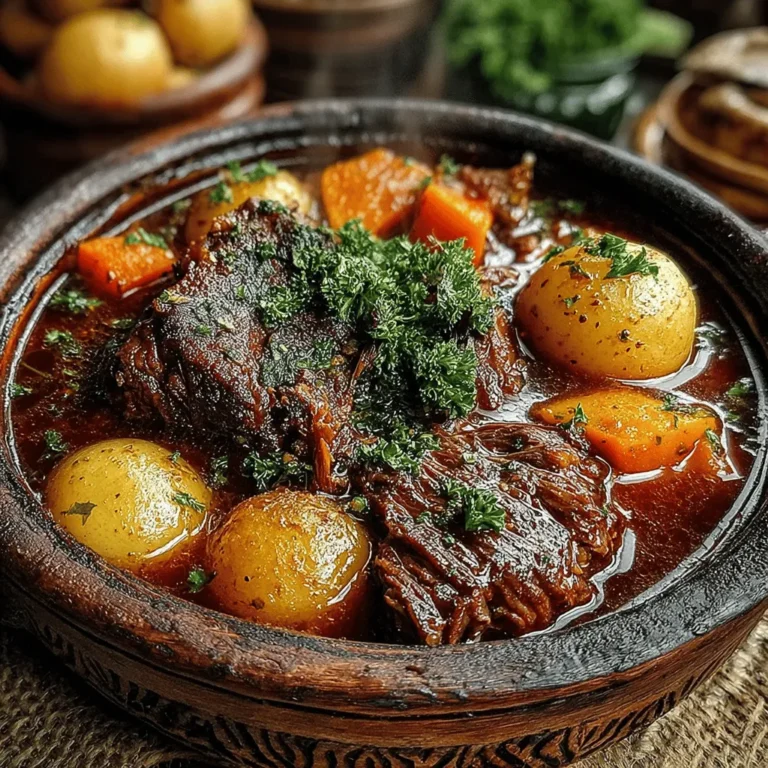Hearty Autumn Beef Stew: A Timeless Comfort Food
As the leaves begin to change and the air turns crisp, the desire for comfort food intensifies. Autumn is a season that beckons for hearty meals, and nothing embodies this better than a bowl of warm, nourishing beef stew. The rich flavors and tender textures of a well-prepared beef stew evoke a sense of coziness that is often associated with gathering around the dinner table with family and friends. This Hearty Autumn Beef Stew is not just a meal; it’s an experience that encapsulates the essence of the season.
When the temperatures drop, our bodies naturally crave foods that are not only filling but also comforting. Hearty meals provide the warmth and sustenance needed to combat the chill outside. A good beef stew is the epitome of this concept, featuring a variety of ingredients that come together to create a dish that is as nourishing as it is delicious. This stew is packed with tender chunks of beef, seasonal vegetables, and aromatic herbs, making it a perfect choice for a family dinner or a cozy night in.
The Essence of Hearty Autumn Beef Stew
The origins of beef stew can be traced back centuries, with variations found in numerous cultures around the world. Traditionally, stews were a practical way to use tougher cuts of meat, relying on slow cooking to break down the fibers and enhance the flavors. This cooking method allows the ingredients to meld together, creating a rich and savory dish that warms both body and soul. In autumn, when the harvest brings a bounty of root vegetables and hearty greens, the appeal of a slow-cooked stew is even more pronounced.
Using seasonal ingredients like butternut squash and parsnips not only elevates the flavor but also promotes sustainability and supports local farmers. These vegetables are at their peak during the autumn months, offering a sweetness and earthiness that complements the robust flavor of the beef. Slow cooking these ingredients allows their natural sugars to caramelize, resulting in a deeper, more complex flavor profile.
Ingredients Breakdown
To create the perfect Hearty Autumn Beef Stew, it’s essential to choose the right ingredients. Each component plays a crucial role in the overall success of the dish.
Beef Chuck: The cornerstone of any beef stew is the meat. Beef chuck is the ideal cut for stews due to its balance of fat and connective tissue. When cooked slowly, it becomes incredibly tender and flavorful, making each bite a delight.
Olive Oil: Starting with high-quality olive oil is key for flavor and health. Extra virgin olive oil not only adds richness to the stew but also provides heart-healthy fats that enhance the overall health benefits of the dish.
Aromatics: Onions and garlic are essential for building the foundation of flavor in this stew. They release their natural sweetness when sautéed, creating a fragrant base that enhances the taste of the entire dish.
Vegetables: A mix of carrots, butternut squash, baby potatoes, and parsnips brings a variety of textures and flavors. Carrots add a hint of sweetness, while butternut squash contributes a creamy consistency. Baby potatoes keep their shape and absorb the stew’s savory broth, and parsnips add a unique, nutty flavor.
Herbs and Spices: Fresh thyme and rosemary are aromatic herbs that complement the beef beautifully. They infuse the stew with earthy notes and enhance the natural flavors of the ingredients.
Worcestershire Sauce and Balsamic Vinegar: These ingredients add depth and acidity, balancing the richness of the beef and the sweetness of the vegetables. Worcestershire sauce brings umami, while balsamic vinegar offers a subtle tang that brightens the dish.
For those with dietary preferences, there are numerous substitutions available. For a plant-based version, consider using mushrooms or tempeh in place of beef, and opt for vegetable broth to create a similar hearty stew without the meat.
Step-by-Step Cooking Instructions
Now that we’ve covered the essential ingredients, let’s dive into the preparation of this comforting dish. Follow these detailed steps to achieve a stew that is not only satisfying but also bursting with flavor.
1. Browning the Beef: Begin by cutting the beef chuck into uniform chunks for even cooking. Pat the pieces dry with paper towels to ensure a good sear. In a large Dutch oven or heavy pot, heat a couple of tablespoons of olive oil over medium-high heat. Add the beef in batches, ensuring not to overcrowd the pot, and brown on all sides. This step is crucial as it develops a deep, rich flavor through the Maillard reaction, which is integral to a delicious stew.
2. Sautéing Aromatics: Once the beef is browned, remove it from the pot and set it aside. In the same pot, add more olive oil if necessary, and lower the heat to medium. Add chopped onions and minced garlic, sautéing until the onions are translucent and fragrant. This step not only enhances the flavor but also adds complexity to the dish.
3. Combining Ingredients: After the aromatics are ready, return the browned beef to the pot, along with a sprinkle of salt and pepper. Next, add your chopped vegetables—carrots, butternut squash, baby potatoes, and parsnips. Mix everything together to coat the vegetables in the flavorful oil and juices. Pour in enough beef broth to cover the ingredients, followed by a splash of Worcestershire sauce and balsamic vinegar. Stir gently to combine all the flavors.
4. Cooking Time Variations: If you’re using a slow cooker, transfer everything to the slow cooker at this point. Set it to low for 6-8 hours or high for 4-5 hours. The low setting allows for a gentle cook, resulting in meat that is fall-apart tender, while the high setting will cook the stew faster but may not achieve the same depth of flavor. If you’re continuing on the stovetop, bring the stew to a boil, then reduce the heat to low and cover the pot. Let it simmer for 1.5 to 2 hours, stirring occasionally, until the beef is tender and the flavors are well developed.
As the stew simmers, your kitchen will fill with the comforting aroma of a meal that promises warmth and satisfaction. The anticipation of that first spoonful makes the entire process worth it, paving the way for a delightful autumn dinner that embraces the season’s bounty.

Visual Aids or Descriptions to Make the Process Easier for Novice Cooks
When it comes to preparing a hearty autumn beef stew, the process can seem daunting for novice cooks. To simplify it, consider using visual aids such as step-by-step images or videos that can be found online on cooking platforms like YouTube. These resources can provide helpful guidance, especially for key steps like browning the beef or chopping the vegetables.
Additionally, here are some straightforward descriptions to assist you:
– Browning the Beef: When you brown the beef, aim for a nice golden crust. This step is crucial as it enhances the flavor of your stew. Use a heavy-bottomed pot or Dutch oven, and ensure the beef is dry before adding it to avoid steaming.
– Chopping Vegetables: Uniformly chop your vegetables to ensure they cook evenly. For instance, cut carrots and potatoes into 1-inch pieces. This not only promotes even cooking but also makes for a visually appealing dish.
– Simmering: When simmering, look for tiny bubbles forming on the surface. This gentle cooking method allows flavors to meld beautifully over time. Keep the pot covered to retain moisture and intensify the stew’s flavor.
These simple descriptions can help demystify the cooking process, making it more approachable for everyone.
The Nutritional Value of Hearty Autumn Beef Stew
Hearty autumn beef stew is not only a delicious comfort food but also a nutritious choice that provides a well-rounded meal. Understanding the nutritional components can enhance your appreciation of this delightful dish.
Caloric Content and Macronutrient Breakdown
A serving of hearty beef stew (approximately 1 cup) typically contains around 300-400 calories, depending on the specific ingredients used. The macronutrient breakdown is generally as follows:
– Protein: 25-30 grams, primarily from the beef, making it an excellent source of protein essential for muscle growth and repair.
– Carbohydrates: 25-30 grams, mainly from the potatoes and carrots, providing energy and fiber.
– Fats: 10-15 grams, which can vary based on the cut of beef and added oils. Choosing lean cuts like chuck roast can help reduce fat content.
Vitamins and Minerals Provided by the Vegetables
The vegetables in your beef stew contribute a wealth of vitamins and minerals. For instance:
– Carrots: Rich in beta-carotene, which is essential for vision and immune function.
– Potatoes: A good source of potassium and vitamin C, supporting heart health and skin integrity.
– Onions and Garlic: Contain antioxidants and compounds that may help reduce inflammation.
Discussion on the Health Benefits of Enjoying a Balanced Meal in Colder Weather
As the temperature drops, hearty meals like beef stew offer not only warmth but also essential nutrients to support your immune system. The combination of protein, carbohydrates, and vegetables provides a balance that is particularly beneficial during the colder months when the body requires more energy to maintain warmth.
How This Stew Can Fit Into a Well-Rounded Diet
Incorporating beef stew into your diet can be part of a balanced meal plan, especially when paired with additional sides such as whole grains or salads. The stew can serve as a filling main dish while allowing for flexibility in side dishes that can enhance nutrient variety.
Serving Suggestions and Pairings
To elevate your beef stew experience, consider these delicious serving suggestions and pairings:
Ideas for Side Dishes that Complement the Stew
1. Crusty Bread or Rolls for Dipping: A warm, crusty baguette or dinner rolls are perfect for soaking up the flavorful broth.
2. Simple Salads to Add Freshness: A light green salad with a tangy vinaigrette can provide a refreshing contrast to the rich stew. Consider ingredients like mixed greens, cherry tomatoes, and cucumbers.
Beverage Pairings that Enhance the Meal Experience
To complement your hearty beef stew, opt for beverages that enhance the meal’s depth:
– Red Wine: A glass of robust red wine, such as Cabernet Sauvignon or Merlot, can harmonize beautifully with the flavors of the stew.
– Herbal Tea: For a non-alcoholic option, a warm cup of herbal tea, perhaps chamomile or peppermint, can cleanse the palate and provide a soothing finish to your meal.
Storing and Reheating Instructions
To make the most of your beef stew, proper storage and reheating are essential:
Best Practices for Storing Leftovers Safely
1. Cool Before Storing: Allow the stew to cool to room temperature before transferring it to airtight containers. This helps prevent condensation and maintains freshness.
2. Refrigerate or Freeze: Store in the refrigerator for up to 3-4 days. For longer storage, consider freezing portions in freezer-safe containers for up to three months.
Tips on Reheating to Maintain Flavor and Texture
When reheating, do so gently on the stove over low heat, stirring occasionally. If the stew has thickened in the fridge, add a splash of broth or water to achieve your desired consistency. Microwave reheating is also an option; just ensure to cover the dish loosely to avoid splatter and maintain moisture.
Ideas for Repurposing Leftover Stew in Other Dishes
Leftover beef stew can also be creatively repurposed into other dishes:
– Shepherd’s Pie: Use the stew as a filling, topping it with mashed potatoes and baking until golden.
– Stew Pasta: Toss leftover stew with cooked pasta for a hearty casserole.
Cultural Variations of Beef Stew
Exploring cultural variations of beef stew can provide inspiration and introduce new flavors to your kitchen:
Brief Exploration of International Beef Stew Variations
– Irish Stew: Typically made with lamb or mutton, potatoes, and onions, simmered slowly to create a comforting dish that showcases the essence of Irish cuisine.
– Hungarian Goulash: A paprika-infused stew that often includes peppers and tomatoes, offering a rich, spicy flavor profile that differs significantly from traditional beef stew.
How Different Cultures Adapt Similar Ingredients to Create Unique Flavors
Each culture adapts common ingredients to reflect local tastes and traditions. For instance, while beef is a staple, some regions might incorporate local spices like cumin or coriander to add warmth and complexity to the dish. Experimenting with these variations can bring an exciting twist to your beef stew.
Encouragement to Experiment with Local Spices and Ingredients
Don’t hesitate to personalize your stew by incorporating local spices or vegetables. For example, adding a hint of chili for heat or using seasonal vegetables available in your area can create a unique and flavorful dish that reflects your culinary origins.
Conclusion
Hearty autumn beef stew stands as a testament to comfort and nourishment during the chilly months. The warmth of this dish not only satisfies hunger but also brings joy and togetherness as we gather around the table with family and friends.
In summary, this stew is not just a meal; it’s an experience that nurtures both body and soul. As you embrace the flavors and richness it offers, remember the joy of sharing meals with loved ones. Cooking this wholesome dish, filled with hearty ingredients and comforting flavors, warms not just the body but also fosters connections that last a lifetime. So, roll up your sleeves, gather your ingredients, and savor the delightful process of creating a meal that embodies the spirit of autumn.


